
Erythrina is a genus of plants in the pea family, Fabaceae. It contains about 130 species, which are distributed in tropical and subtropical regions worldwide. They are trees, with the larger species growing up to 30 m (98 ft) in height. The generic name is derived from the Greek word ερυθρóς erythros, meaning "red", referring to the flower color of certain species.
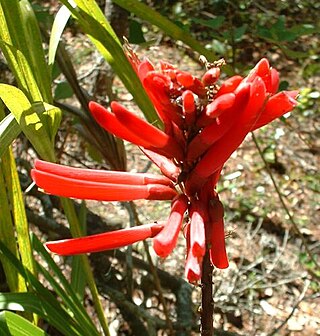
Erythrina herbacea, commonly known as the coral bean, Cherokee bean, Mamou plant in South Louisiana, red cardinal or cardinal spear, is a flowering shrub or small tree found throughout the southeastern United States and northeastern Mexico; it has also been reported from parts of Central America and, as an introduced species, from Pakistan. Various other systematic names have been used for this plant in the past, including Erythrina arborea, Erythrina hederifolia, Erythrina humilis, Erythrina rubicunda, Corallodendron herbaceum and Xyphanthus hederifolius.
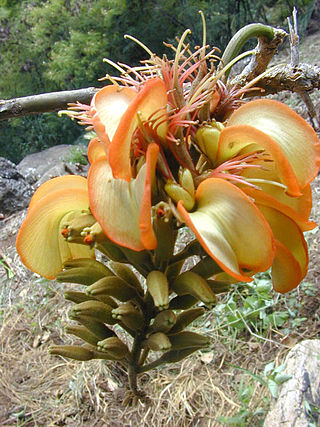
Wiliwili is a species of tree in the pea family, Fabaceae, that is endemic to the Hawaiian Islands. It is the only species of Erythrina that naturally occurs there. It is typically found in Hawaiian tropical dry forests on leeward island slopes up to an elevation of 600 m (2,000 ft).
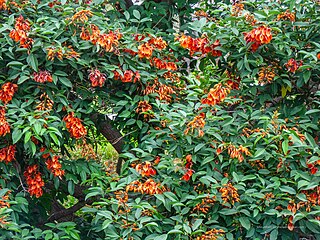
Erythrina crista-galli, also known as the cockspur coral tree, ceibo or corticeira, is a species of flowering tree in the family Fabaceae, native to Argentina, Uruguay, southern Brazil and Paraguay. It is widely planted as a street or garden tree in other countries, notably in California. Its specific epithet crista-galli means "cock's comb" in Latin.

Erythrina variegata, commonly known as tiger's claw or Indian coral tree, is a species of Erythrina native to the tropical and subtropical regions of eastern Africa, the Indian subcontinent, northern Australia, and the islands of the Indian Ocean and the western Pacific Ocean east to Fiji.

Erythrina fusca is a species of flowering tree in the legume family, Fabaceae. It is known by many common names, including purple coraltree, gallito, bois immortelle, bucayo, and the more ambiguous "bucare" and "coral bean". E. fusca has the widest distribution of any Erythrina species; it is the only one found in both the New and Old World. It grows on coasts and along rivers in tropical Asia, Oceania, the Mascarene Islands, Madagascar, Africa, and the Neotropics.
Erythrina ankaranensis is a species of legume in the family Fabaceae. It is found only in Madagascar.
Erythrina elenae is a species of legume in the family Fabaceae. It is found only in Cuba. It is threatened by habitat loss.

Erythrina haerdii is a species of legume in the family Fabaceae. It is found only in Tanzania.
Erythrina perrieri is a species of legume in the family Fabaceae. It is found only in Madagascar.

Erythrina sacleuxii is a species of legume in the family Fabaceae. It is found in Kenya and Tanzania.
Erythrina schliebenii is a species of legume in the family Fabaceae. It is found only in Tanzania. The species is named for German collector and botanist Hans-Joachim Schlieben.
Erythrina tahitensis is a tree in the family Fabaceae. It is endemic to the island of Tahiti in the Society Islands of French Polynesia.
Erythrina tuxtlana is a species of legume in the family Fabaceae. It is found only in Mexico.
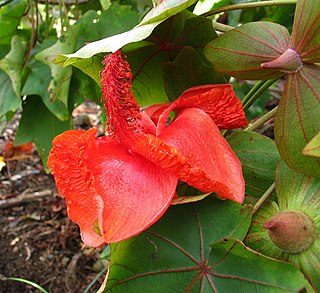
Kokia drynarioides, commonly known as Hawaiian tree cotton, is a species of flowering plant in the mallow family, Malvaceae, that is endemic to the Big Island of Hawaii. It inhabits dry forests at elevations of 455–1,915 m (1,493–6,283 ft). Associated plants include ʻāheahea, ʻaʻaliʻi, hala pepe, wiliwili, uhiuhi, kōlea, ʻaiea, kuluʻī, ʻālaʻa, ʻohe kukuluāeʻo, māmane, and maua. It is threatened by habitat loss and competition with invasive species, such as fountain grass.
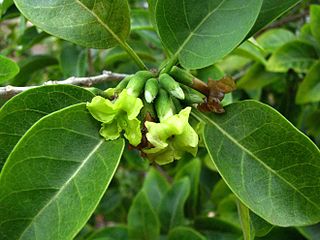
Nothocestrum breviflorum, commonly known as smallflower ʻaiea, is a species of tree in the nightshade family, Solanaceae, that is endemic to the island of Hawaiʻi. It inhabits dry and mixed mesic forests at elevations of 180–1,830 m (590–6,000 ft). These forests are dominated by ʻōhiʻa lehua and koa or lama, while plants associated with smallflower ʻaiea include wiliwili and uhiuhi. N. breviflorum reaches a height of 10–12 m (33–39 ft). It is threatened by habitat loss. It is federally listed as an endangered species of the United States. There are fewer than 50 individuals remaining.
Dracaena konaensis, synonym Pleomele hawaiiensis, the Hawaiʻi hala pepe, is a rare species of flowering plant that is endemic to the island of Hawaiʻi in the state of Hawaii.
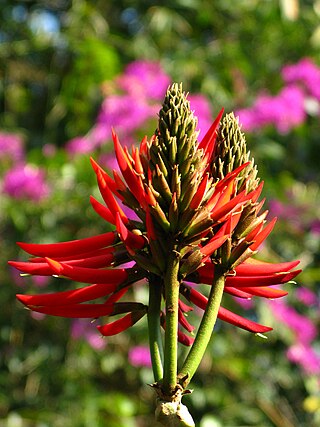
Erythrina speciosa is a tree native to Brazil, which is often cultivated and has introduced populations in Africa and India. It is pollinated by hummingbirds.

Erythrina senegalensis, the Senegal coraltree, is a plant in the pea family Fabaceae, native to West Africa.

The reddish myzomela is a species of bird in the family Meliphagidae. It is endemic to Papua New Guinea, where it is found on New Ireland and adjacent islands. Its natural habitats are subtropical or tropical moist lowland forests and subtropical or tropical moist montane forests.













